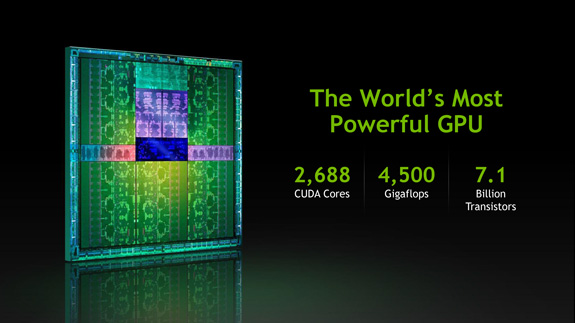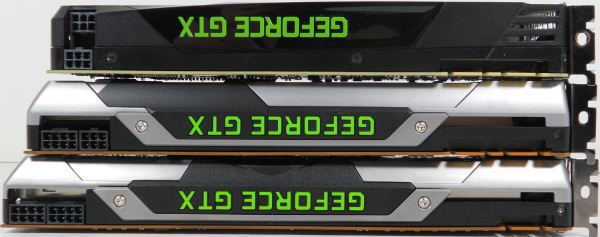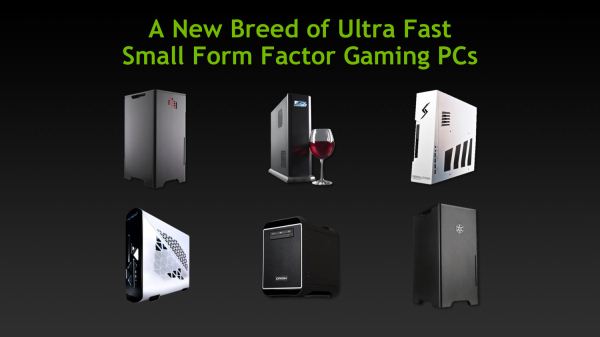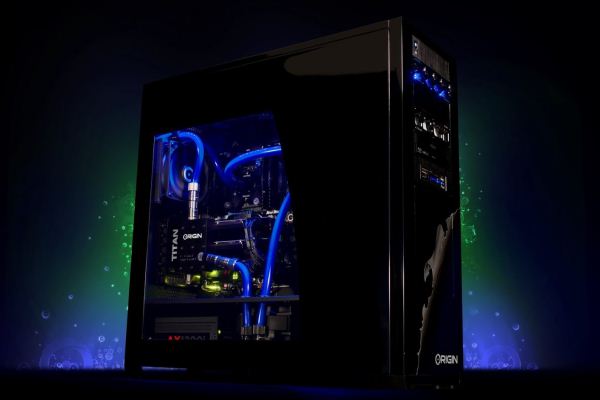NVIDIA's GeForce GTX Titan, Part 1: Titan For Gaming, Titan For Compute
by Ryan Smith on February 19, 2013 9:01 AM ESTWho’s Titan For, Anyhow?
Having established performance expectations, let’s talk about where Titan fits into NVIDIA’s product stack. First and foremost, though Titan is most certainly geared in part as a gaming video card (and that’s largely how we’ll be looking at it), that’s not the only role it serves. Titan is also going to be NVIDIA’s entry-level compute card. We’ll dive more into why that is in a bit in our feature breakdown, but the biggest factor is that for the first time on any consumer-level NVIDIA card, double precision (FP64) performance is uncapped. That means 1/3 FP32 performance, or roughly 1.3TFLOPS theoretical FP64 performance. NVIDIA has taken other liberties to keep from this being treated as a cheap Tesla K20, but for lighter workloads it should fit the bill.
As compared to the server and high-end workstation market that Tesla carves out, NVIDIA will be targeting the compute side of Titan towards researchers, engineers, developers, and others who need access to (relatively) cheap FP64 performance, and don’t need the scalability or reliability that Tesla brings. To that end Titan essentially stands alone in NVIDIA’s product stack; the next thing next to a FP64-constrained consumer card is the much more expensive Tesla K20.

Far more complex will be the gaming situation. Titan will not be pushing anything down in NVIDIA’s product stack, rather NVIDIA’s product stack will be growing up to accompany Titan. Like the GTX 690, NVIDIA is going to position Titan as a premium/luxury product, releasing it at the same $999 price point. GTX 690 itself will continue to exist at the same $999 price point, meanwhile GTX 680 will continue at its current price point of roughly $450.
Continuing the GTX 690 analogies, Titan will not only be sharing in GTX 690’s price point, but also in its design principles and distribution. This means Titan is a well-built card with its housing composed primarily of metals, with the same kind of luxury finish as the GTX 690. On the distribution side of things Asus and EVGA are once again NVIDIA’s exclusive partners for North America, and they will essentially be distributing reference Titan cards. In time we will see some specialized variation, with water-cooling in particular being an obvious route for EVGA to go. Factory overclocks are also on the table.
With the above in mind, it goes without saying that while GTX 690 had some historical precedence in its price, the same cannot be said for Titan. The price of NVIDIA’s top-tier single-GPU video cards hovered around $500 for the GeForce 400/500 series, and while they attempted to launch at $650 for the GTX 280, the launch of the Radeon HD 4870 quickly brought that price down to earth. As such this will be the most expensive single-GPU product out of NVIDIA yet.

Top To Bottom: GTX 680, GTX Titan, GTX 690
Ultimately NVIDIA is not even going to try to compete on a price-performance basis with Titan. There are a number of potential reasons for this – ranging from the competitive landscape to yields to needs for GK110 GPUs elsewhere within NVIDIA – and all of those reasons are probably true to some extent. Regardless, NVIDIA believes that like the GTX 690 they can sell Titan as a luxury product, and hence $999. The GTX 680 and below will compose NVIDIA’s more traditional price-performance competitive fare.
As to be expected from such a price, NVIDIA’s marketing department will be handling Titan in a similar fashion as they did GTX 690. This not only includes reiterating the fact that Titan is intended to be a luxury product, but also focusing on markets where luxury products are accepted, and where Titan in particular makes sense.
Perhaps not surprisingly, with $999 video cards the makeup of consumers shifts away from both traditional big-box OEMs and DIY builders, and towards boutique builders. Boutique builders are essentially already in the business of providing luxury computers, offering an outlet for luxury buyers who need not spend their time building their own computer, and want something of higher quality than what the typical OEM provides. As such while Titan will be sold on the open market just as like any other card, NVIDIA tells us that they expect a lot of those buyers are going to be the boutiques.
For Titan in particular, NVIDIA is going to be focusing on two boutique computer concepts, reflecting the blower design of Titan as opposed to the front/back exhausting design of the GTX 690. The first concept will be SFF PCs, where blowers are a necessity due to a lack of space (and often, a lack of heavy sound dampening), and where such cards can draw fresh air in from outside the chassis.
On the other end of the spectrum will be the ultra-enthusiast market where one Titan isn’t enough, and even two may come up short. Again thanks to the fact that it’s a blower, Titan can easily be fit in an ATX motherboard for tri-SLI operation, which NVIDIA envisions not just as the ultimate gaming computer, but the ultimate NV/3D Surround computer in particular. Multi-monitor gaming with graphically intensive games can quickly nullify the performance of even a single Titan card, so tri-SLI is NVIDIA’s solution to driving three monitors as well as one Titan can drive one monitor. At the same time however, NVIDIA intends to showcase that a tri-SLI system doesn’t need to be loud, despite the cramped conditions and despite the 750W+ that 3 Titans will pull, thanks to the high quality construction of the cards. Tri-SLI has been possible for a number of years, but NVIDIA believes with Titan in particular they have a solid grip on the heat and noise concerns it typically comes with.
To that end, as part of the Titan launch NVIDIA has shipped out a number of boutique systems in either a SFF or tri-SLI full tower configuration to reviewers, in order to show off their usage concepts in completed and well-constructed systems. Anand received a SFF Tiki from Falcon Northwest, while I have received a tri-SLI equipped Genesis from Origin PC. Like Titan itself we can’t talk about the performance of these systems, but we’ll be able to go into greater detail on Thursday when the complete NDA lifts. In the meantime we’ve been able to post a few impressions, which we’ve put up on their respective articles.
Moving on, with a $999 launch price NVIDIA’s competition will be rather limited. The GTX 690 is essentially a companion product; NVIDIA’s customers can either get the most powerful single-GPU card NVIDIA offers in a blower design, or an alternative design composed of two lesser GPUs in SLI, in a front and rear exhausting design. The GTX 690 will be the faster card, but at a higher TDP and with the general drawbacks of SLI. On the other hand Titan will be the more consistent card, the lower TDP card, the easier to cool card, but also the slower card. Meanwhile though it’s not a singular product, the GTX 680 SLI will also be another option, offering higher performance, higher TDP, more noise, and a cheaper price tag of around $900.
As for AMD, with their fastest single-GPU video card being the 7970 GHz Edition, offering performance closer to the GTX 680 than Titan, Titan essentially sits in a class of its own on the single-GPU front. AMD’s competition for Titan will be the 7970GE in CrossFire, and then the officially unofficial 7990 family, composed of the air-cooled PowerColor 7990, and the closed loop water-cooled Asus Ares II. But with NVIDIA keeping GTX 690 around, these are probably closer competitors to the multi-GPU 690 than they are the single-GPU Titan.
Finally, let’s talk launch availability. By scheduling the launch of Titan during the Chinese New Year, NVIDIA has essentially guaranteed this is a delayed availability product. Widespread availability is expected on the 25th, though cards may start popping up a couple of days earlier. NVIDIA hasn’t gone into depth for launch quantities, but they did specifically shoot down the 10,000 card rumor; this won’t be a limited run product and we don’t have any reason at this time to believe this will be much different from the GTX 690’s launch (tight at first, but available and increasingly plentiful).
| February 2013 GPU Pricing Comparison | |||||
| AMD | Price | NVIDIA | |||
| $1000 | GeForce GTX Titan/690 | ||||
| (Unofficial) Radeon HD 7990 | $900 | ||||
| Radeon HD 7970 GHz Edition | $450 | GeForce GTX 680 | |||
| Radeon HD 7970 | $390 | ||||
| $350 | GeForce GTX 670 | ||||
| Radeon HD 7950 | $300 | ||||












157 Comments
View All Comments
TheJian - Wednesday, February 20, 2013 - link
http://www.guru3d.com/articles-pages/geforce_gtx_t...1176mhz from 876 (boost). No bad for $2500 K20 basically for $1000. I've never done homework on it, but I don't think K20's overclock, but I could be wrong.
Can't wait to see the review tomorrow. Clearly he'll bench it there and he has 3 :) You should get your answers then :)
I'm wondering if some hacker will enable the K20 drivers, or if that's possible. It seems a lot of reviewers got 3, so you should have lots of data by weekend.
Bill Brasky - Tuesday, February 19, 2013 - link
There were rumors this card would launch at 799-899, which made more sense. But for a grand this thing better be pretty darn close to 690.wand3r3r - Tuesday, February 19, 2013 - link
The price tag just makes this card a failure. It's a 580 replacement no matter how they label it, so they can shove it. They lost a potential customer...karasaj - Tuesday, February 19, 2013 - link
So what is the 680?Sandcat - Tuesday, February 19, 2013 - link
A GK104, which replaced the GF104,The GK110 is the replacement for the GF110, which was the GTX 580.
Ananke - Tuesday, February 19, 2013 - link
the 680 was meant as a 560ti replacement...however, NVidia decided it turns too good to be sold too cheap, and changed the model numbering...I have several close friends in the marketing at NV :)However, NV is using this GK110 core for HPComputing for the very beginning in the Quadro cards, since there they really cannot skip on the double precision.
CeriseCogburn - Sunday, February 24, 2013 - link
BS.The 680 core is entirely different, the rollout time is over half a year off, and that just doesn't happen on a whim in Jan2012 with the post mental breakdown purported 7970 epic failure by amd...
So after the scat lickers spew the 7970 amd failure, they claim it's the best card ever, even now.
R O F L
Have it both ways rumor mongering retreads. No one will notice... ( certainly none of you do).
rolodomo - Tuesday, February 19, 2013 - link
Their business model has become separating money from the wallets of well-to-do who have no sense of value and technology (NVIDIA's PR admits this in the article ). It is a business model, but boutique. Doesn't do much for the their name brand in the view of the technorati either (NVIDIA: We Market to Suckers).Wreckage - Tuesday, February 19, 2013 - link
It's almost as fast as a pair of 7970's that cost $1100 at launch.AMD set the bar on high prices. Now that they are out of the GPU race, don't expect much to change.
At least NVIDIA was able to bring a major performance increase this year. While AMD has become the new Matrox.
Stuka87 - Tuesday, February 19, 2013 - link
AMD is out of the GPU race? What are you smoking? A $1000 dollar card does not put AMD out of the GPU race. The 7970GE competes well with the 680 for less money (They go back and forth depending on the game).Now if this card was priced at $500 then that would hurt AMD as the prices on the 660/670/680 would all drop. But its not the case, so your point is moot. Not to mention this card was due out a year ago, and it got delayed. Which is why the GK104 was bumped up to the 680 slot.